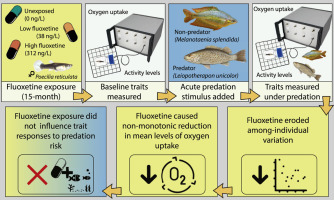当前位置:
X-MOL 学术
›
Environ. Pollut.
›
论文详情
Our official English website, www.x-mol.net, welcomes your
feedback! (Note: you will need to create a separate account there.)
Chronic exposure to a pervasive pharmaceutical pollutant erodes among-individual phenotypic variation in a fish.
Environmental Pollution ( IF 7.6 ) Pub Date : 2020-04-05 , DOI: 10.1016/j.envpol.2020.114450 Hung Tan 1 , Giovanni Polverino 2 , Jake M Martin 1 , Michael G Bertram 3 , Sarah C Wiles 1 , Maria M Palacios 4 , Candice L Bywater 1 , Craig R White 5 , Bob B M Wong 1
Environmental Pollution ( IF 7.6 ) Pub Date : 2020-04-05 , DOI: 10.1016/j.envpol.2020.114450 Hung Tan 1 , Giovanni Polverino 2 , Jake M Martin 1 , Michael G Bertram 3 , Sarah C Wiles 1 , Maria M Palacios 4 , Candice L Bywater 1 , Craig R White 5 , Bob B M Wong 1
Affiliation

|
Pharmaceutical pollution is now recognised as a major emerging agent of global change. Increasingly, pharmaceutical pollutants are documented to disrupt ecologically important physiological and behavioural traits in exposed wildlife. However, little is known about potential impacts of pharmaceutical exposure on among-individual variation in these traits, despite phenotypic diversity being critical for population resilience to environmental change. Furthermore, although wildlife commonly experience multiple stressors contemporaneously, potential interactive effects between pharmaceuticals and biological stressors-such as predation threat-remain poorly understood. To redress this, we investigated the impacts of long-term exposure to the pervasive pharmaceutical pollutant fluoxetine (Prozac®) on among-individual variation in metabolic and behavioural traits, and the combined impacts of fluoxetine exposure and predation threat on mean metabolic and behavioural traits in a freshwater fish, the guppy (Poecilia reticulata). Using a mesocosm system, guppy populations were exposed for 15 months to one of two field-realistic levels of fluoxetine (nominal concentrations: 30 and 300 ng/L) or a solvent control. Fish from these populations were then tested for metabolic rate (oxygen uptake) and behaviour (activity), both before and after experiencing one of three levels of a predation treatment: an empty tank, a non-predatory fish (Melanotaenia splendida) or a predatory fish (Leiopotherapon unicolor). Guppies from both fluoxetine treatments had ∼70% lower among-individual variation in their activity levels, compared to unexposed fish. Similarly, fluoxetine exposure at the higher dosage was associated with a significant (26%) reduction in individual-level variation in oxygen uptake relative to unexposed fish. In addition, mean baseline metabolic rate was disrupted in low-fluoxetine exposed fish, although mean metabolic and behavioural responses to predation threat were not affected. Overall, our study demonstrates that long-term exposure to a pervasive pharmaceutical pollutant alters ecologically relevant traits in fish and erodes among-individual variability, which may be detrimental to the stability of contaminated populations globally.
中文翻译:

慢性暴露于普遍的药物污染物会腐蚀鱼类的个体表型变异。
如今,制药污染已被公认为是全球变化的主要新兴动力。越来越多的文献证明,药物污染物会破坏裸露的野生生物在生态上重要的生理和行为特征。然而,尽管表型多样性对于人群对环境变化的适应能力至关重要,但对于这些特征的个体差异对药物暴露的潜在影响知之甚少。此外,尽管野生生物通常同时经历多个压力源,但人们对药物和生物压力源之间潜在的相互作用(例如掠食威胁)的了解仍然很少。为了解决这个问题,我们调查了长期接触无处不在的药物污染物氟西汀(Prozac®)对个体代谢和行为特征变化的影响,以及氟西汀暴露和捕食威胁对淡水鱼平均代谢和行为特征的综合影响,孔雀鱼(Poecilia reticulata)。使用中观宇宙系统,孔雀鱼种群暴露于两种现场实际水平的氟西汀(标称浓度:30和300 ng / L)或溶剂对照中,持续15个月。然后,在经历以下三种捕食处理水平之一之前和之后,对这些种群中的鱼的代谢率(摄氧量)和行为(活动)进行测试:空罐,非掠食性鱼(Melanotae splendida)或掠食性鱼(Leiopotherapon单色)。与未暴露的鱼相比,两种氟西汀处理的孔雀鱼的活动水平个体差异均低约70%。同样,相对于未暴露的鱼类,较高剂量的氟西汀暴露与个体摄氧水平显着降低(26%)有关。此外,低氟西汀暴露的鱼类的平均基线代谢率被破坏,尽管对捕食威胁的平均代谢和行为反应没有受到影响。总体而言,我们的研究表明,长期接触无处不在的药物污染物会改变鱼类和糜烂中与生态相关的性状,并导致个体间的变异,这可能会损害全球受污染人群的稳定性。同样,相对于未暴露的鱼类,较高剂量的氟西汀暴露与个体摄氧水平显着降低(26%)有关。此外,低氟西汀暴露的鱼类的平均基线代谢率被破坏,尽管对捕食威胁的平均代谢和行为反应没有受到影响。总体而言,我们的研究表明,长期接触无处不在的药物污染物会改变鱼类和糜烂中与生态相关的性状,并导致个体间的变异,这可能会损害全球受污染人群的稳定性。同样,相对于未暴露的鱼类,较高剂量的氟西汀暴露与个体摄氧水平显着降低(26%)有关。此外,低氟西汀暴露的鱼类的平均基线代谢率被破坏,尽管对捕食威胁的平均代谢和行为反应没有受到影响。总体而言,我们的研究表明,长期接触无处不在的药物污染物会改变鱼类和糜烂中与生态相关的性状,并导致个体间的变异,这可能会损害全球受污染人群的稳定性。低氟西汀暴露的鱼类的平均基线代谢率被破坏,尽管对捕食威胁的平均代谢和行为反应没有受到影响。总体而言,我们的研究表明,长期接触无处不在的药物污染物会改变鱼类和糜烂中与生态相关的性状,并导致个体间的变异,这可能会损害全球受污染人群的稳定性。低氟西汀暴露的鱼类的平均基线代谢率被破坏,尽管对捕食威胁的平均代谢和行为反应没有受到影响。总体而言,我们的研究表明,长期接触无处不在的药物污染物会改变鱼类和糜烂中与生态相关的性状,并导致个体间的变异,这可能会损害全球受污染人群的稳定性。
更新日期:2020-04-06
中文翻译:

慢性暴露于普遍的药物污染物会腐蚀鱼类的个体表型变异。
如今,制药污染已被公认为是全球变化的主要新兴动力。越来越多的文献证明,药物污染物会破坏裸露的野生生物在生态上重要的生理和行为特征。然而,尽管表型多样性对于人群对环境变化的适应能力至关重要,但对于这些特征的个体差异对药物暴露的潜在影响知之甚少。此外,尽管野生生物通常同时经历多个压力源,但人们对药物和生物压力源之间潜在的相互作用(例如掠食威胁)的了解仍然很少。为了解决这个问题,我们调查了长期接触无处不在的药物污染物氟西汀(Prozac®)对个体代谢和行为特征变化的影响,以及氟西汀暴露和捕食威胁对淡水鱼平均代谢和行为特征的综合影响,孔雀鱼(Poecilia reticulata)。使用中观宇宙系统,孔雀鱼种群暴露于两种现场实际水平的氟西汀(标称浓度:30和300 ng / L)或溶剂对照中,持续15个月。然后,在经历以下三种捕食处理水平之一之前和之后,对这些种群中的鱼的代谢率(摄氧量)和行为(活动)进行测试:空罐,非掠食性鱼(Melanotae splendida)或掠食性鱼(Leiopotherapon单色)。与未暴露的鱼相比,两种氟西汀处理的孔雀鱼的活动水平个体差异均低约70%。同样,相对于未暴露的鱼类,较高剂量的氟西汀暴露与个体摄氧水平显着降低(26%)有关。此外,低氟西汀暴露的鱼类的平均基线代谢率被破坏,尽管对捕食威胁的平均代谢和行为反应没有受到影响。总体而言,我们的研究表明,长期接触无处不在的药物污染物会改变鱼类和糜烂中与生态相关的性状,并导致个体间的变异,这可能会损害全球受污染人群的稳定性。同样,相对于未暴露的鱼类,较高剂量的氟西汀暴露与个体摄氧水平显着降低(26%)有关。此外,低氟西汀暴露的鱼类的平均基线代谢率被破坏,尽管对捕食威胁的平均代谢和行为反应没有受到影响。总体而言,我们的研究表明,长期接触无处不在的药物污染物会改变鱼类和糜烂中与生态相关的性状,并导致个体间的变异,这可能会损害全球受污染人群的稳定性。同样,相对于未暴露的鱼类,较高剂量的氟西汀暴露与个体摄氧水平显着降低(26%)有关。此外,低氟西汀暴露的鱼类的平均基线代谢率被破坏,尽管对捕食威胁的平均代谢和行为反应没有受到影响。总体而言,我们的研究表明,长期接触无处不在的药物污染物会改变鱼类和糜烂中与生态相关的性状,并导致个体间的变异,这可能会损害全球受污染人群的稳定性。低氟西汀暴露的鱼类的平均基线代谢率被破坏,尽管对捕食威胁的平均代谢和行为反应没有受到影响。总体而言,我们的研究表明,长期接触无处不在的药物污染物会改变鱼类和糜烂中与生态相关的性状,并导致个体间的变异,这可能会损害全球受污染人群的稳定性。低氟西汀暴露的鱼类的平均基线代谢率被破坏,尽管对捕食威胁的平均代谢和行为反应没有受到影响。总体而言,我们的研究表明,长期接触无处不在的药物污染物会改变鱼类和糜烂中与生态相关的性状,并导致个体间的变异,这可能会损害全球受污染人群的稳定性。











































 京公网安备 11010802027423号
京公网安备 11010802027423号